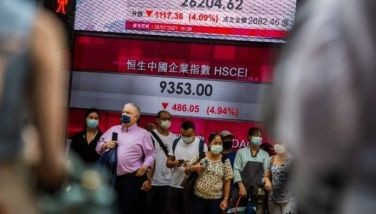Hanjin Philippines shipbuilding bankruptcy

The Philippine business community was rocked on Jan. 8 by the announcement of the bankruptcy of Hanjin Heavy Industries and Construction Philippines – the Korean shipbuilding company based in the country.
The biggest corporate bankruptcy. This is the biggest corporate bankruptcy to ever hit the Philippines. Hanjin is the biggest foreign investor in the Subic Bay Freeport Zone.
According to news reports, the firm has sought, in a court filing before the regional court in Subic, voluntary rehabilitation under Republic Act 10142. This law, only recently passed in 2010, provides the appropriate mechanisms for the rehabilitation or liquidation of financially distressed companies.
Hanjin Philippines has become financially distressed due to its heavy debt. With revenues falling behind, it cannot support its operations anymore under the burden of its current debt.
According to the same reports, Hanjin owes $412 million to Philippine banks. Another $900 million is owed to Korean banks. So far, little is known about these debts and how the actual value of the assets of the company relate to its capacity to repay.
It is widely believed that the assets of the company, only so recently constructed, are more valuable compared to the debts owed.
What caused the problems for Hanjin Philippines? An unexpected glut in shipbuilding demand caused by continued uncertainties in world trade is the reason. Perhaps too, its company culture.
Although they are separate companies, Hanjin Heavy Industries and Construction, the shipbuilding company, might have suffered reputational damage with the bankruptcy of Hanjin Shipping Co. in 2017.
This latter company, the shipping and logistics company of the Hanjin Group, the 7th largest in the world, was the flagship company of the Hanjin Group.
A financial drama of decline and mismanagement/and corruption played out in South Korea during 2016. Eventually in February 2017, the Korean courts declared the company bankrupt and to be liquidated.
This event set off a worldwide ripple effect in the world container industry that caused worldwide supply chain and shipping disruption. Loaded cargo ships were stuck in ports and at sea.
According to industry watchers, Hanjin Shipping’s bankruptcy was, to the world’s shipping, the equivalent of the Lehman Brothers collapse of recent memory.
Philippine bank exposure. Five of the country’s biggest banks have lent to the Korean shipbuilder: Rizal Commercial Banking Corp., the Land Bank of the Philippines, Metropolitan Bank and Trust Corp., the Bank of the Philippine Islands, and Banco de Oro Universal Bank. .
Collectively, Hanjin owes them $412 million. The Philippine banks have reportedly moved together to improve the chances of collecting against the reformed company.
The Philippine central bank, speaking through its deputy governor Chuchi Fonacier, stated that Hanjin’s debts only account for 0.24 percent of total gross loans of the Philippine banking system and 2.48 percent of foreign currency loans made by local banks. From this standpoint, the situation is less alarming.
The modern Subic shipbuilding yard. Hanjin’s history as an industrial enterprise in the Philippines is fairly recent. It began constructing its shipyard in 2006 on raw land of nearly 300 hectares in Zambales province as a foreign investment locator within the Subic Freeport area. Two years later, it made its first ship delivery.
It is a subsidiary of Hanjin Heavy Industries and Construction Co. Ltd., a multinational company based in Busan, Korea. The parent company is part of the large Hanjin Group that has grown rapidly with the rapid swift industrialization of Korea.
The company undertakes the construction of big merchant vessels used in international commerce. According to the Subic Bay Metropolitan Authority (SBMA), the shipyard investment is $2.3 billion.
This has enabled the shipyard to manufacture big cargo and container ships, bulk carriers, liquefied petroleum gas carriers of crude oil and mineral ores. According to SBMA, Hanjin Philippines has built 123 merchant vessels for international customers.
The company is one of the big employers in the country. It has reached an employment of around 20,000 workers. The shipbuilding workforce is mainly dominated by skilled welders.
Along with the other big shipbuilding company, Tsuneishi, the Japanese shipbuilder located in Cebu, the Philippines has become a major shipbuilding nation. The government through the Department of Industry states that based on gross tonnage built, the Philippines has become the fourth largest shipbuilder in the world today.
This status could be threatened by the bankruptcy and potential demise of Hanjin Philippines.
Prospects for rehabilitation. Any time a company suffers from financial distress, its value as a going enterprise deteriorates. Also, the value of the debts that creditors hope to collect falls.
This is equally true with the value of its investment assets. Financial needs could lead to neglect of maintenance or the separation through sale of redundant assets.
If it is an important and viable economic activity, opportunities for reorganization and rehabilitation are always present either through new investments to rebuild the productive assets or through the fall in the value of the debt owed, or both.
The actors – debtors and creditors and interested parties – are many. Debtors and creditors have in general opposing interests, but the demise of the company and the liquidation of assets among the creditors may not always be in their best interest. In such cases, they could open opportunities for new investors to bring life to the distressed company.
The government has an interest in seeing to it that the enterprise could be saved. That route is often likely to improve the chance of creditors getting paid a higher fraction of the original loans.
Creditors could also have a strong interest in getting their act together by forcing a sale of the company to a viable investor that could bring it back to life.
Quo vadis? Hanjin Philippines has sought the help of the government to find a buyer that could take over the shipbuilding operations.
It is reported that Chinese foreign investors with shipbuilding interests are looking over the possibility of buying into the Hanjin investment. The Chinese investors could see this as a major opportunity in locating in a recently constructed major facility which has a rich supply of skilled labor resource.
My email is: [email protected]. For archives of previous Crossroads essays, go to: https://www.philstar.com/authors/1336383/gerardo-p-sicat. Visit this site for more information, feedback and commentary: http://econ.upd.edu.ph/gpsicat/
- Latest
- Trending





























